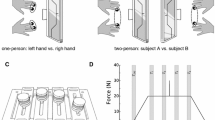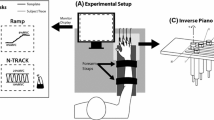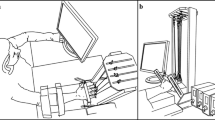Abstract
We analyzed patterns of covariation among forces produced by the five digits of the human hand during tasks that required the production of a pattern of the total force consisting of ramp-up, constant force, and ramp-down segments with the time of the ramps ranging from 0 to 3000 ms. Patterns of the variance of the total force and the sum of the variances of individual digit forces were compared over sets of 12 trials at each task. The initiation of the ramp-up segment was associated with positive covariation of digit forces. Negative covariation among digit forces (force-stabilizing synergies) emerged after a critical time of 600–800 ms, which was only weakly dependent on the ramp time. These synergies persisted over the steady-state phase. A quantitative index of digit force covariation was introduced; it showed a drop about 100 ms before initiation of the ramp-down phase; we termed this phenomenon “anticipatory covariation” (ACV). The ramp-down phase was associated with rapid disappearance of the force-stabilizing synergy over a time period that ranged from 0 to 600 ms and scaled strongly with the duration of the force ramp. Thumb-virtual finger synergies showed qualitatively similar behavior to the multi-finger synergies (virtual finger is an imagined digit whose action is mechanically equivalent to the action of the four fingers). We conclude that abrupt changes in a time profile of total force are associated with transient destabilization of the total force. Changes in force-stabilizing synergies may occur in preparation to changes in the total force.











Similar content being viewed by others
References
Arbib MA, Iberall T, Lyons D (1985) Coordinated control programs for movements of the hand. In: Goodwin AW, Darian-Smith I (eds) Hand function and the neocortex. Springer-Verlag, Berlin; Exp Brain Res (Suppl 10)
Baud-Bovy G, Soechting JF (2001) Two virtual fingers in the control of the tripod grasp. J Neurophysiol 86:604–615
Bazalgette D, Zattara M, Bathien N, Bouisset S, Rondot P (1986) Postural adjustments associated with rapid voluntary arm movements in patients with Parkinson’s disease. Adv Neurol 45:371–374
Belenkiy VY, Gurfinkel VS, Pal’tsev YI (1967) Elements of control of voluntary movements. Biofizika 10:135–141
Bernstein NA (1935) The problem of interrelation between coordination and localization. Arch Biol Sci 38:1–34
Bernstein NA (1996) On dexterity and its development. In: Latash ML, Turvey MT (eds) Dexterity and its development. Erlbaum Publication, Mahwah NJ, pp 207–235
Bouisset S, Zattara M (1987) Biomechanical study of the programming of anticipatory postural adjustments associated with voluntary movement. J Biomech 20:735–742
Bouisset S, Zattara M (1990) Segmental movement as a perturbation to balance? Facts and concepts. In: Winters JM, Woo SL-Y (eds) Multiple muscle systems. Biomechanics and movement organization. edited by Springer-Verlag, New York, pp 498–506
Cordo PJ, Nashner LM (1982) Properties of postural adjustments associated with rapid arm movements. J Neurophysiol 47:287–302
Haken H, Kelso JAS, Bunz H (1985) A theoretical model of phase transitions in human hand movements. Biol Cybern 51:347–356
Horak FB, Esselman PE, Anderson ME, Lynch MK (1984) The effects of movement velocity, mass displaced and task certainty on associated postural adjustments made by normal and hemiplegic individuals. J Neurol Neurosurg Psychiat 47:1020–1028
Kelso JAS (1984) Phase transitions and critical behavior in human bimanual coordination. Am J Physiol 246:R1000–R1004
Kelso JAS (1995) Dynamic patterns: the self-organization of brain and behavior. MIT Press, Cambridge
Kugler PN, Turvey MT (1987) Information, natural law, and the self-assembly of rhythmic movement. Erlbaum, Hillsdale NJ
Lang CE, Schieber MH (2003) Differential impairment of individuated finger movements in humans after damage to the motor cortex or the corticospinal tract. J Neurophysiol 90:1160–1170
Latash ML, Scholz JF, Danion F, Schöner G (2001) Structure of motor variability in marginally redundant multi-finger force production tasks. Exp Brain Res 141:153–165
Latash ML, Scholz JP, Schöner G (2002) Motor control strategies revealed in the structure of motor variability. Exer Sport Sci Rev 30:26–31
Latash ML, Danion F, Scholz JF, Schöner G (2003) Coordination of multi-element motor systems based on motor abundance. In: Latash ML, Levin MF (eds.) Progress in motor control:effects of age, disorder, and rehabilitation, vol 3. Human Kinetics, Urbana IL, pp 97–124
Lee WA, Buchanan TS, Rogers MW (1987) Effects of arm acceleration and behavioral conditions on the organization of postural adjustments during arm flexion. Exp Brain Res 66:257–270
Li Z-M, Latash ML, Zatsiorsky VM (1998) Force sharing among fingers as a model of the redundancy problem. Exp Brain Res 119:276–286
Loève M (1977) Probability theory I, 4th edn. Springer-Verlag, New York NY
MacKenzie CL, Iberall T (1994) The grasping hand. North Holland, Amsterdam
Massion J (1992) Movement, posture and equilibrium: interaction and coordination. Prog Neurobiol 38:35–56
Moore KL (1992) The upper limb. In: Clinically oriented anatomy. Williams & Wilkins, Baltimore
Olatsdottir H, Zatsiorsky VM, Latash ML (2004) Is the thumb a fifth finger? A study of digit interaction during force production tasks. Exp Brain Res 160:203–213
Penfield W, Rasmussen T (1950) The cerebral cortex of man. MacMillan, New York
Saltzmann EL, Kelso JAS (1987) Skilled actions: a task-dynamic approach. Psychol Rev 94:84–106
Santello M, Soechting JF (2000) Force synergies for multifingered grasping. Exp Brain Res 133:457–467
Schieber MH (2001) Constraints on somatotopic organization in the primary motor cortex. J Neurophysiol 86:2125–2143
Scholz JP, Danion F, Latash ML, Schöner G (2002) Understanding finger coordination through analysis of the structure of force variability. Biol Cybern 86:29–39
Scholz JP, Kang N, Patterson D, Latash ML (2003) Uncontrolled manifold analysis of single trials during multi-finger force production by persons with and without Down syndrome. Exp Brain Res 153:45–58
Schoner G (1990) A dynamic theory of coordination of discrete movement. Biol Cybern 63:257–270
Shim JK, Latash ML, Zatsiorsky VM (2003) The central nervous system needs time to organize task-specific covariation of finger forces. Neurosci Lett 353:72–74
Shim JK, Lay B, Zatsiorsky VM, Latash ML (2004) Age-related changes in finger coordination in static prehension tasks. J Appl Physiol 97:213–224
Shinohara M, Li S, Kang N, Zatsiorsky VM, Latash ML (2003) Effects of age and gender on finger coordination in maximal contractions and submaximal force matching tasks. J Appl Physiol 94:259–270
Shinohara M, Scholz JP, Zatsiorsky VM, Latash ML (2004) Finger interaction during accurate multi-finger force production tasks in young and elderly persons. Exp Brain Res 156:282–292
Todorov E, Jordan MI (2002) Optimal feedback control as a theory of motor coordination. Nat Neurosci 5:1226–1235
Turvey MT (1990) The challenge of a physical account of action: a personal view. In: Whiting HTA, Meijer OG, van Wieringen PCW (eds) The natural-physical approach to movement control. VU University Press, Amsterdam, pp 57–92
Viallet F, Massion J, Massarino R, Khalil R (1987) Performance of a bimanual load-lifting task by Parkinsonian patients. J Neurol Neurosurg Psychiat 50:1274–1283
Woollacott M, Inglin B, Manchester D (1988) Response preparation and posture control. Neuromuscular changes in the older adult. Ann NY Acad Sci 515:42–53
Zajac FE (1989) Muscle and tendon: properties, models, scaling, and application to biomechanics and motor control. CRC Crit Rev Biomed Eng 17:359–411
Zatsiorsky VM, Li Z-M, Latash ML (1998) Coordinated force production in multi-finger tasks. Finger interaction, enslaving effects, and neural network modeling. Biol Cybern 79:139–150
Zatsiorsky VM, Latash ML, Gao F, Shim JK (2004) The principle of superposition in human prehension. Robotica 22:231–234
Acknowledgments
We are grateful to Brendan Lay for his help at early stages of this project. The study was in part supported by NIH grants NS-35032, AG-018751, and AR-048563.
Author information
Authors and Affiliations
Corresponding author
Rights and permissions
About this article
Cite this article
Shim, J.K., Olafsdottir, H., Zatsiorsky, V.M. et al. The emergence and disappearance of multi-digit synergies during force-production tasks. Exp Brain Res 164, 260–270 (2005). https://doi.org/10.1007/s00221-005-2248-3
Received:
Accepted:
Published:
Issue Date:
DOI: https://doi.org/10.1007/s00221-005-2248-3




